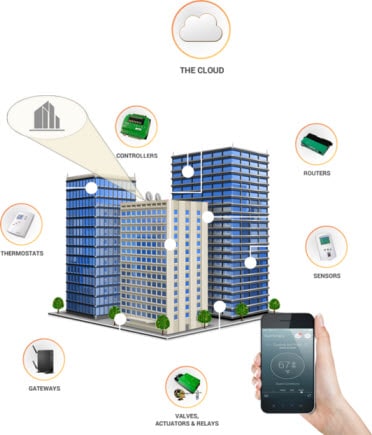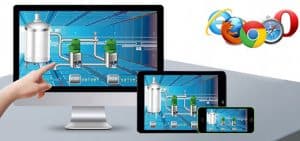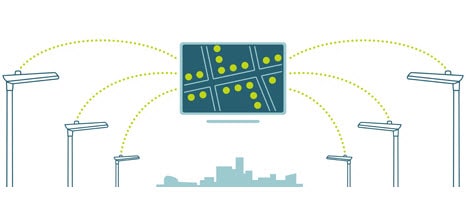Internet of Things (IOT) and Its Applications
What is Internet of Things (IOT) and Its Examples and Applications
Several recent digital and smart manufacturing technologies, and design innovations besides the internet connectivity origins Internet of Things (IOT) to become a revolutionary technology in transforming many areas of modern day living.
Though the inception of IOT was started in the context of supply chain management, it has been evolved into a wide range of applications such as transport, utilities, industrial automation, healthcare, building and home automation, etc. The smart connectivity with existing networks though IOT results in ubiquitous, computer sense information without the aid of human intervention.
What is Internet of Things (IOT)?
Interne of Things is an emerging paradigm of internet connected things that allows the physical objects or things to connect, interact and communicate with one another similar to the way humans talk through web in today’s environment. It connects systems, sensors and actuator instruments to the broader internet.
The applications of IOT are not limited to particular fields, but span a wide range of applications such as energy systems, homes, industries, cities, logistics, health, agriculture and so on.
The goal of IOT is not only just connecting things such as machines, devices and appliances, but also allows the things to communicate, exchange control data and other necessary information while executing applications towards machine goal.
It consist of IOT devices that have unique identities and capable of performing remote sensing, monitoring and actuating tasks. These devices capable of interacting with one another directly or indirectly and also data collection are performed locally or remotely via centralized serves or cloud based applications. These devices can be data collection devices to which various sensors are attached such as temperature, humidity, light, etc. or they can be data actuating devices to which actuators are connected such as relays.
It is a global network in which computers, sensors and actuators are interconnected through internet protocols. For example, consider the figure below in which a computer communicates with a device consisting of sensor, over the internet. The TCP/IP protocol is used as internet protocol in such cases.
The Internet of Things (IOT) is also impacted industrial sector, especially for industrial automation systems in which internet infrastructure makes an extensive access to sensors, controls and actuators, with a goal of increasing efficiency.
Industrial Internet of Things (IIOT) collects data from connected devices (i.e., smart connected devices and machines) in the field or plant and then processes this data using sophisticated software and networking tools. The entire IIOT requires a collection of hardware, software, communications and networking technologies.
Applications of Internet of Things
There will be 26 billion devices connected to the internet of things by 2020 according to Gartner Inc. The applications of the IOT are not restricted to some group of areas, but can be applied to a wide variety of domains whether individual, industry or infrastructure. IOT products are classified based on the type of application. These can be smart wearable, smart city, smart home, smart enterprise, or smart environment. Some of the application areas of IOT are discussed below.
Home and Building Automation
IOT devices are used to monitor and control electronic, electrical and mechanical systems in homes and buildings in order to improve convenience and safety. The tasks of IOT in this domain include
- Smart lighting by adapting ambient conditions based switching
- Web application and mobile apps enabled wireless and internet connected lights
- Smart appliances management and control
- Intrusion detection systems, alarm systems and surveillance systems
- Safety systems such as smoke and gas detection
- Home entertainment management such as video, audio and projectors
Industries
IOT deals with real-time optimization of production and supply chain networks in a manufacturing industry by networking sensors, actuators, control systems and machinery together. In case of process industries, it automates the process controls, service information systems and operator tools using digital controllers in order to achieve enhanced productivity and safe distribution system.
The tasks of Industrial Internet of Things (IIOT) are
- Real-time monitoring and control of processes
- Deploying smart machines, smart sensors, and smart controllers with proprietary communication and internet technologies
- Maximize safety, security and reliability through high precision automation and control
Related Post: What Exactly Is A Smart Grid? Smart Grid Applications
Energy
The major area where IOT deals with energy management systems is the smart grid. IOT extends the benefits of smart grid beyond the automation, distribution and monitoring being done by the utilities. The task of the IOT in the field of electrical energy includes
- Advanced Metering Infrastructure (AMI)
- SCADA (Supervisory Control and Data Acquisition)
- Smart Inverters
- Remote control operation of energy consuming devices
Medical and Healthcare Systems

- Remote health monitoring
- Emergency notification systems
- Wearable IOT devices
- Medication remainder
- Real-time infant monitoring
Related Post: What is Industrial Automation | Types of Industrial Automation
Transportation
IOT can integrate control, information processing and communications across various transportation systems by establishing an interconnection between drivers or users and vehicles. The tasks of the IOT in transportation include
- Smart traffic control
- Unmanned autonomous navigation
- Inter and intra vehicular communication
- Automatic transmission for emergency rescue
- Electronic toll collection system
- Safety and road assistance
- Smart parking
Related Post: Smart WiFi Circuit Breaker – Construction, Installation and Working
Environment
IOT in the field of environment monitoring consists of different environmental parameter sensors such as air, water, soil, etc. with cloud based applications so that weather monitoring, pollution check and early warning systems (such as fire, earthquake and tsunami) can be achieved effectively. IOT duties in this field include
- Cloud-based weather monitoring
- Noise and air pollution monitoring
- Fire detection systems
- Earthquake and tsunami early warning systems
- Soil condition monitoring
Related Posts:
- How to Install PoE IP CCTV Cameras with NVR Security System
- How to Install a CCTV Camera? CCTV Camera Installation with DVR
Examples of IOT Usage in the Electrical Power Industry
The evaluation of the IOT in the electrical power industry transformed the way things performed in usual manner. IOT increased the use of wireless technology to connect power industry assets and infrastructure in order to lower the power consumption and cost. Some of the examples of IOT usage include SCADA, smart metering, building automation, smart grid, and connected public lighting.
SCADA
SCADA is one of the major application areas of IOT. SCADA allows the centralized monitoring and control of remote located generation and transmission systems. It consists of sensors, actuators, controllers and communication devices at the remote field place, and central master unit with communication systems at the controlling side. It collects the data from sensors in the field and provides a user interface in HMI at central station. Also, it stores the time-stamped data for later analysis.
IOT SCADA is a step beyond SCADA that has been in use from earlier days. It provides real-time signal acquisition and data logging through IOT servers and internet technologies. It integrates the individual devices, machines, sensors and other electrical equipment with internet by realizing the functionality of supervision and control.
Smart Metering
Smart metering is an essential element in smart grid implementations as they are using Internet of Things technologies to transform traditional energy infrastructure. Smart metering through IOT helps to reduce operating costs by managing metering operations remotely. It also improves the forecasting and reduces energy theft and loss. These meters simply capture the data and send it back to the utility companies over highly reliable communication infrastructure.
Building Automation
IOT based solutions enable the efficient way of monitor and control of buildings to property owners as they connect lighting systems, elevators, environmental systems and other electrical appliances with internet and communication technologies. It saves the power consumption by automatically turning off the lights when rooms are not occupied and also by making sure of not drawing too much power by appliances. IOT based appliances provide remote monitoring and control through mobile and web applications to the end users or owners.
- Related Post: Smart Home Automation System
Connected Public Lighting
This is the part of a project under smart cities where wireless IOT solutions are deployed to connect IP based lights. This smart public lighting uses intelligent-connected outdoor LED luminaries which are centrally controlled from the control station. This type of infrastructure also facilitates dynamical adjustment of illumination based on environmental changing conditions. This would dramatically result lower operating costs and power consumption.
Smart Grid
As discussed above that smart meter is a key part of the smart grid and there are millions of smart meters already connected to the grid. Smart grid makes better use of available energy supply by optimizing electricity generation and distribution depending upon the load demand.
This includes Ethernet based communication connected substations with intelligent equipment devices at each substation. This enables the automation of substations which can be coordinated effectively for a better power distribution especially during peak hours.
- Related Post: What is Distributed Control System (DCS)?
IOT in smart grid determines parts where the lacking power and excessive power taking place at a given point of time and accordingly helps the generating stations to come online to fill up the gap.
With the use of internet connected smart meters at individual customers, smart grid collects the current load data instead of historical data and then control local energy generation and load. This can also implement an efficient way of energy measures and billing the consumers.
The smart meter data can also be used for improving the real-time identification of grid fault location and restoration. Another benefit from IOT based smart grid is that it can schedule the consumers to operate their high wattage loads when demand on the grid is low.
This is something about IOT (Internet of Things) and its applications in electrical field. Hope this is informative to the readers. Please feel free to share your thoughts about this new and evolving topic in the comment section.
Related Posts:
- What is Arduino and How to Program it?
- What is Raspberry Pi? Creating Projects using Raspberry Pi
- What is ZigBee Technology and How it works?
- What is MEMS – Microelectromechanical Systems Technology ?
- Programmable Logic Controllers (PLC) for Industrial Control


















This is indeed informative! Keep it up.
Very good article which provides basic understanding of IoT and applications in power systems.
This was really helpful,specially how the explained smart grid and automatic metering infrastructure.
Los felicito por la excelente labor que realizan con esto conocimientos tan necesarios para actualizarse.
Very informative article. Like to see more information about the internet protocol and frequency for communication. Also interesting to see information on the Cyber Security aspect.
Thank you
thank you very much for your content
smart education
Could you possible to suggest the course for working professionals related to IoT Energy and Utility Industry.